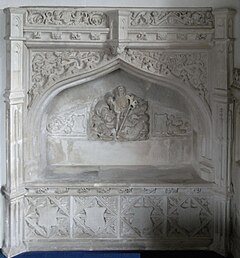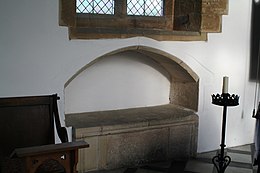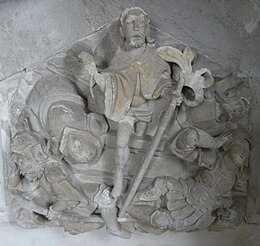Easter Sepulchre

An Easter Sepulchre is a feature of British church interior architecture.
Description

The Easter Sepulchre is an arched recess generally in the north wall of the chancel, in which from Good Friday to Easter day were deposited the crucifix and sacred elements in commemoration of Christ's entombment and resurrection. It was generally only a wooden structure, which was placed in a recess or on a tomb.[1]
Distribution
The Easter Sepulchre is only found in England and Wales, the practice having been peculiar to the Sarum Rite. However, there is a ruin presumed to be an Easter sepulchre at Kildrummy in north-east Scotland.
Use

The Easter Sepulchre contained the Blessed Sacrament of the altar, the Host. Following the doctrine of the Real Presence, i.e. that Jesus is physically present within the Host, on Good Friday the Host was taken from the tabernacle where it had been placed following the Maundy Thursday celebration of the Last Supper and, wrapped in linen cloths, 'buried' in the Easter sepulchre which was found on the north wall of the sanctuary. Cut into the wall, it was sometimes ornately carved but within it was a wooden frame on which was hung a cloth pall often embroidered with scenes from the Passion. Candles were lit around the sepulchre, burial clothes adorned it, and parishioners stood guard until early Easter morning at the first Mass. The Host was brought out, in imitation of Jesus having arisen out of the tomb, and was placed again in the tabernacle in the centre of the Church.[2] Like Roods and their lofts, Easter Sepulchres were the object of iconoclastic fury by the Protestant Reformers, and few are left.
Surviving examples
There are throughout Great Britain many fine examples in stone, some of which are Decorated Gothic, such as:
Cumbria
Devon
- Holcombe Burnell[1]
- Bishops Nympton
- Heanton Punchardon
- Monkleigh
- St Mary's Church, Berry Pomeroy
- Throwleigh
Dorset
Glamorgan
Herefordshire
Lincolnshire
- Navenby[1]
- Heckington (1370)[1]
London
Norfolk
Northamptonshire
Nottinghamshire
Oxfordshire
Suffolk
- Cockfield
- East Harling
- Long Melford
- St Margaret South Elmham
Warwickshire
- Long Itchington[1]
- Withybrook, Coventry
West Sussex
East Riding of Yorkshire
See also
Notes
- ^ a b c d e f g h i Chisholm 1911, p. 655.
- ^ Duffy, Eamon (February 2015). The Stripping of the Altars: Traditional Religion in England, 1400–1580. New Haven & London: Yale University Press. p. 29. ISBN 978-0-300-06076-8.
- ^ "Fritton - St. Catherine's Church". Julian White. 2 April 2021. Archived from the original on 2021-04-03.
References
- Attribution
- This article incorporates text from a publication now in the public domain: Chisholm, Hugh, ed. (1911). "Sepulchre, Easter". Encyclopædia Britannica. Vol. 24 (11th ed.). Cambridge University Press. p. 655.
